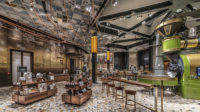Global Store Development In-House Architects
Arthur Rubinfeld, President
U.S., The Netherlands, Japan
What started in 1971 as a small stand in downtown Seattle has evolved into a global enterprise. Today, Starbucks, a publicly traded company, has more than 17,000 stores in 58 countries, from Malaysia to Norway, and earned $11.7 billion in revenue during its last fiscal year. Its cultural contribution is most profound in the United States, where it popularized the Italian coffeehouse tradition yet gave it an American twist, offering gussied-up espresso drinks to stay or to go. A Starbucks pit stop is now a daily ritual for many.
The retailer's shops often share a uniform look. Still, Starbucks has always aimed to craft artful spaces that respond to their context and serve as gathering hubs, says architect Arthur Rubinfeld, president of global development. In recent years, the company has raised its design ambitions to venti-sized proportions, opening branches that generate considerable buzz for their distinct styles. Here, we feature four such examples, designed mostly by in-house teams.
First up: the company's maiden concept store in Europe. Located in the vault of a converted bank in Amsterdam, the expansive café contains areas for poetry readings and jam sessions, a wall covered in used bicycle tubes, and a dramatic ceiling installation made of wooden blocks. Other standout features include oak furnishings, Delft blue tiles, and a mural that pays tribute to the Dutch coffee trade. The architects were inspired by the history of the Netherlands and its contemporary role “as a creative capital,” says Liz Muller, director of global concept design.
Over in Japan, two equally striking facilities point toward Starbucks's growing commitment to singular architecture. In the city of Dazaifu, on a street leading to a shrine visited by 2 million people annually, sits a head-turning café by Kengo Kuma & Associates (the building's owner asked the coffee company to work with Kuma). To enliven the space, the architect inserted a weblike composition of thin, elongated wooden blocks into the empty shell. “I wanted to recreate the beauty of the Japanese wooden structure in the modern context,” says Kuma, adding that the organic material fits nicely with Starbucks's “comfortable” atmosphere.
Wood was also integral to the design of a freestanding store in a Fukuoka City park, but in a much different way. The quiet, low-slung building was clad in FSC-certified cedar and was “purposefully nestled into a grove of trees, to help it blend into the environment,” says architect John Harrison, a Starbucks design manager. The project boasts a bevy of sustainable elements, including on-site composting and an exterior shade screen. According to Harrison, it's Japan's first LEED-NC retail project. (Starbucks has pledged to earn LEED certification for all of its new stores.)
While foreign countries have proved fertile testing grounds, Starbucks's most adventurous project was conceived stateside. Located in Tukwila, Washington, “Reclamation Drive-Thru” is composed of four cargo containers and is meant to be transient (the landowner wanted a temporary facility). Beyond being environmentally responsible, the structure is “intended to be expressive and provocative,” says Anthony Perez, a senior concept design manager. “We've never done this before. It's created a lot of conversation.” With projects like this spurring dialogue and making headlines, who knows what the coffee superpower will brew up next.
Architect:
Starbucks Global Store Development in-house architects
Arthur Rubinfeld, president; Kengo Kuma & Associates (Dazaifu, Japan)
PeopleClient: Starbucks Coffee at Dazaifutenmangu OmotesandoLocation: 3-2-43 Zaifu, Dazaifu, Fukuoka Prefecture Completion Date: Nov 2011 Gross square footage: 210.03 Owner: Manten Corporation Architect: Personnel in architect's firm who should receive special credit: Interior designer: KENGO KUMA & ASSOCIATES , Starbucks Coffee Japan, Ltd. Engineer(s): Jun Sato Structural Engineers Consultant(s):Junji Ito General contractor: Matsumoto-gumi Corporation Photographer(s): Renderer(s): CAD system, project management, or other software used: Starbucks Ohori ParkLocation: Fukuoka, Japan Completion Date: May, 2010 Gross square footage: 1,730 s.f. Total construction cost: 1.5 million dollar (1dollar = 82 yen) Owner: Starbucks Coffee Company/Starbucks Coffee Japan Architect: Personnel in architect's firm who should receive special credit: Interior designer: Starbucks Coffee Company/Starbucks Coffee Japan Consultant(s): Arup Japan-LEED Consultants/Commissioning Agent: Kentaro Suga, YukiyoKikuchi General contractor: Matsumoto-gumi corporation Photographer(s): Starbucks Reclamation DTLocation: Tukwila, WA Completion Date: 12/2011 Gross square footage: 448 Total construction cost: Withheld Owner: Starbucks Coffee Company Architect: Personnel in architect's firm who should receive special credit: Note: all individuals listed above are employees of Starbucks Coffee Company Architect of record: Fulton (Tony) Gale, FAIA-Starbucks Corporate Architect Engineer(s): MEP: Rensch Engineering General contractor: DB Contractors-Jake Hatfield, Project Manager-Jeremy Habelman, Superintendent Photographer(s): |
ProductsStarbucks Coffee at Dazaifutenmangu OmotesandoExterior cladding Metal/glass curtain wall: tempered glass t15 Wood: wood joinery; cedar 60*60 (ETO KOBO) Moisture barrier: water proof membrane Roofing Metal: galvalume; aluminum-zing alloy-coated steel sheet Windows Glazing Skylights: Low-e FL6+A6+FW6.8 (Ryoko co.,ltd.) Doors Interior finishes Cabinetwork and custom woodwork: harvest panel (AD WORLD,TIME & STYLE) Wall coverings: cement wood chip board t20 Furnishings Fixed seating: (TIME & STYLE) Chairs: (TIME & STYLE) Tables: (TIME & STYLE) Upholstery: (TIME & STYLE) Lighting Downlights: LED downlight (DAIKO) Task lighting: (DAIKO) Exterior: LED downlight ,indirect lighting LED line (DAIKO) Starbucks Ohori ParkStructural system Exterior cladding Roofing Windows Glazing Doors Other doors: Glass Hinged door Interior finishes Floor and wall tile: Mortar floor Raised flooring: Bamboo flooring Lighting HVAC Starbucks Reclamation DTAdd any additional building components or special equipment that made a significant contribution to this project: Insulation: Demilec Heatlok (soy based closed cell foam) |





















Post a comment to this article
Report Abusive Comment